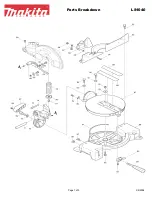
37
GB
General power tool safety warnings / Safety notices specific to the device
Safety notices specific to the device
of a tooth should be visible from under the
work piece.
d)
Never hold the work piece with your
hand or lay it over a leg. Secure the
work piece on a stable fixture.
It is im-
portant to fix the work piece safely, to minimise
the danger of contact with the body, jamming
of the saw blade or loss of control.
e)
Only hold the power tool by the insu-
lated handles when undertaking work
where the tool may strike hidden elec-
tric lines.
Contact with a live wire could cause
metal parts of the power tool to become live
and lead to electric shock.
f)
When cutting along the way always
use a fence or a straight edge guide.
That improves the precision of the cut and mini-
mises the possibility that the saw blade jams.
g)
Always use saw blades of the correct
size and with matching mounting hole
(e.g. star-shaped or round).
Saw blades
not matching the attachments of the saw run
untrue and lead to loss of control.
h)
Never use damaged or incorrect saw
blade washers or bolts.
The saw blade
washers and screws were specifically developed
for your saw, for optimal performance and op-
erating safety.
Additional safety notices
for all saws
Kickback - causes and related safety notices
-
Kickback is a sudden reaction if the saw blade
catches, jams or is misaligned and the uncon-
trolled saw lifts out of the work piece and in the
direction of the operator.;
-
If the saw blade becomes caught or jammed in
the closing sawing gap, it seizes and the power
of the motor kicks the saw back toward the op-
erator.;
-
If the saw blade is distorted or misaligned in
the saw gap, the teeth of the rear blade edge
can jam in the surface of the work piece, caus-
ing the saw blade to move out of the saw gap
and the saw to kick back toward the operator.
Kickback is the result of misuse or incorrect use of
the saw. It can be avoided by taking the in the fol-
lowing described precautions.
a)
Hold the saw with both hands and
bring your arms into a position that
allows you to absorb the forces of the
kickback. Always stand to the side of
the saw blade, never bring the saw
blade into a line with your body.
Dur-
ing a kickback the saw can jump backwards,
however, the operator can master the forces of
the kickback with suitable preventive measures.
b)
Should the saw blade jam, or you stop
the work, switch the saw off and hold
it still in the work piece, until the saw
blade has come to a standstill. Never
attempt to remove the saw from the
work piece or to pull it backwards, as
long as the saw blade moves, as oth-
erwise a kickback could occur.
Find out
and rectify the reason for the jamming of the
saw blade.
c)
If you want to restart a saw that is
stuck in the work piece, centre the saw
blade in the saw gap and check that
the teeth are not stuck in the work piece.
If the saw blade jams, it can move out of the work
piece or cause kickback if the saw is restarted.
d)
Support big boards to reduce the risk
of a kickback due to a jamming saw
blade.
Big boards can bend through due to
their own weight. Boards must be supported
at both ends, both near the saw gap as well
as near at the edge.
e)
Do not use blunt or damaged saw
blades.
Saw blades with blunt or
misaligned
teeth cause greater friction, jamming of the blade
and kickback due to the saw gap being too tight.
f)
Tighten the blade depth and blade an-
gle before making your cut.
If the adjust-
ments change during cutting, the saw blade can
jam and cause a kickback.
g)
Take particular care when cutting into
existing walls or other areas which
cannot be inspected.
The saw blade can
jam when cutting into hidden objects, causing
kickback
.
Summary of Contents for PTS 500 A1
Page 3: ...1 4 A 10 5 6 11 D 18 17 16 9 F 7 7a 1 1a 3 6 E 19 20 22 21 C 14 13 1 1a 2 B 8 15 12...
Page 4: ......
Page 18: ...18...
Page 32: ...32...









































